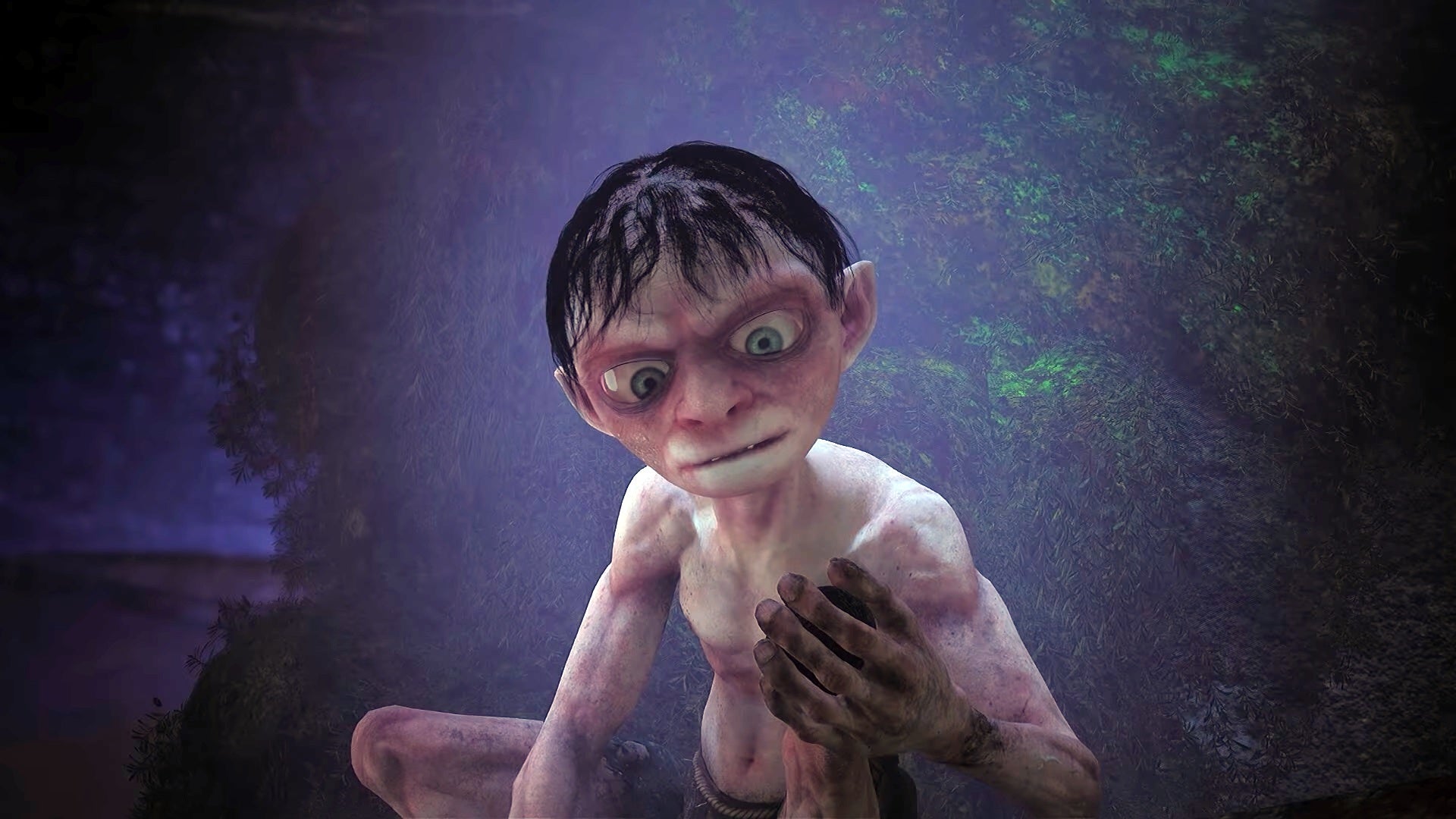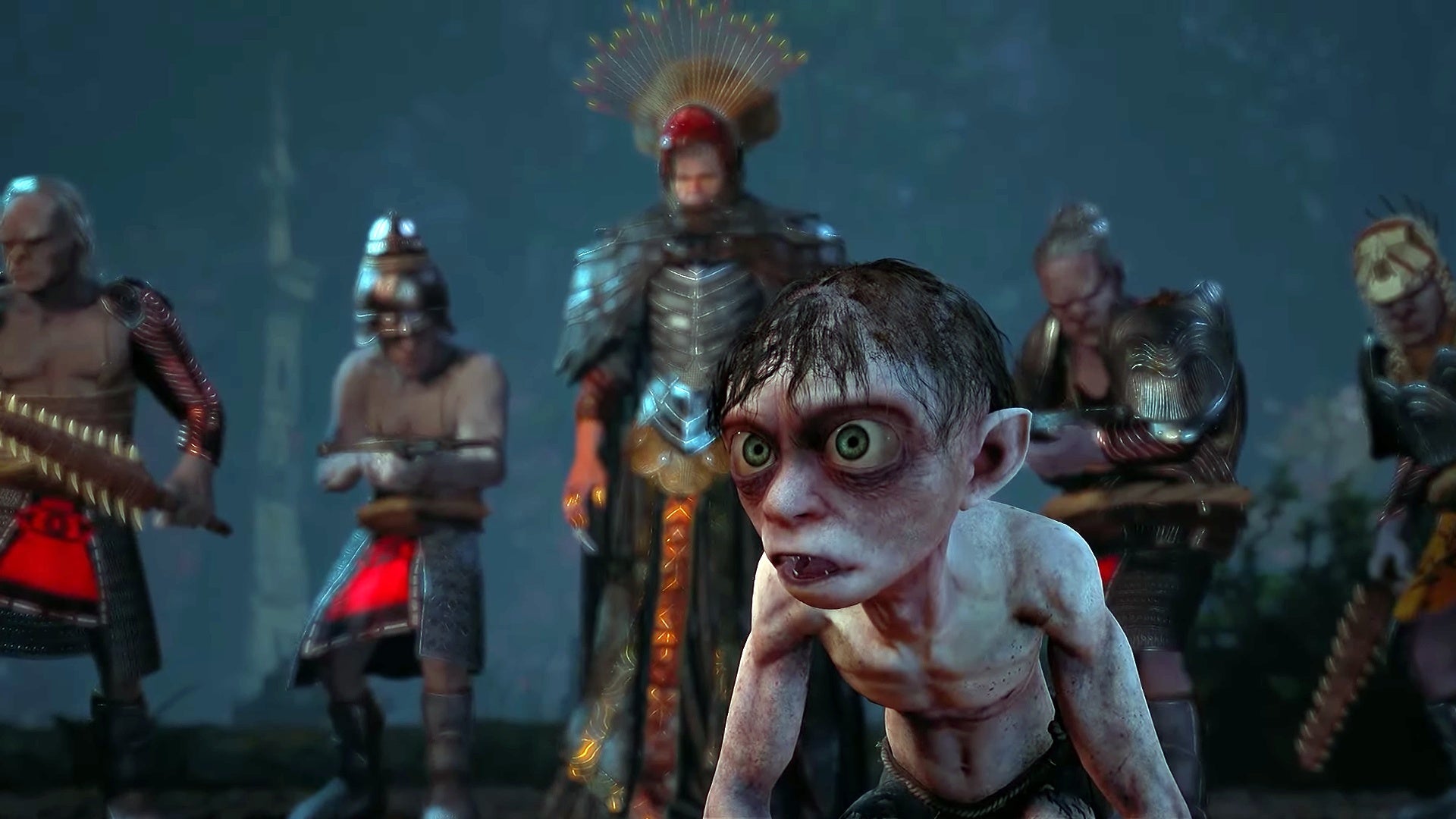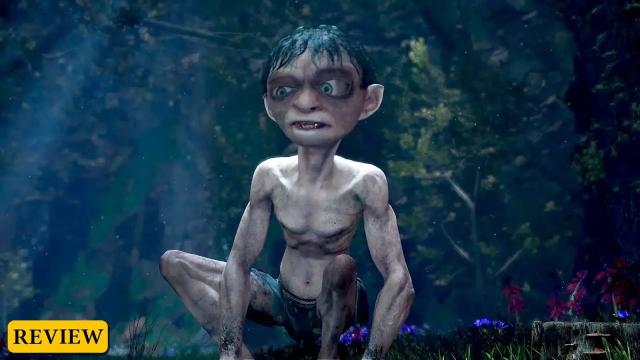After hours of dodging orcs and ducking spiders, I found Shelob’s lair. I’m a slave in The Lord of the Rings: Gollum, performing tasks like collecting tags and herding animals for maybe a bite of rotted bread. I was aching to escape. Meeting Shelob seemed like the first real attempt at bargaining for freedom. So, I fed the spider queen a newly captured slave, thinking the meal would humanize her arachnid heart. I was wrong. A cutscene triggered and, before I even hit the ground to start her chase sequence, Shelob snatched me up, making me simultaneously the victim of Tolkien’s fearsome spider and one of the game’s many bugs. I died twice: in the stealth-action game and in real life, as I laughed at the ridiculousness.
Read More: The Lord Of The Rings Game About Gollum Is Getting Absolutely Roasted
This incongruity between cutscene and gameplay is emblematic of Gollum, a narrative-adventure game about the gangly, Ring-addled former hobbit’s experiences before the events of The Fellowship of the Ring. It’s not enough to say that this game is busted. Gollum, like J.R.R. Tolkien’s character himself, is a miserable wretch. It’s at once thematically compelling and mechanically deficient, always at war with itself to the point of self-defeat. If you want to know what it’s like to be Gollum, developer Daedalic Entertainment’s The Lord of the Rings: Gollum will totally give you that. But no one, not even Gollum, wants to be Gollum, and this game is indicative of that.
The slavery of Gollum
Gollum is set between the 1937 novel The Hobbit and the first volume of The Lord of the Rings. The story, told through 10 vignettes the white wizard Gandalf teases out of him in some strange therapy session within a Mirkwood cell, follows the eponymous character across Middle-earth as he mumbles about getting The Ring of Power back into his slimy little fingers. You’ll encounter some iconic characters, including Legolas’ dad Thranduil and the Mouth of Sauron, but most of who you’ll meet are new, non-canonical characters to the Tolkien universe. As such, Daedalic Entertainment’s take on Gollum is an original narrative with an interesting conceit, one centered on the lengths one will go to for freedom. It culminates in a somewhat choice-based, stealth-action game cut from the same cloth as Cyanide Studio’s Styx franchise.
This means you’ll climb, jump, run, and slither through Middle-earth locations, such as the dark fortress Barad-dûr and the mountain pass Cirith Ungol, while doing rote errands and plotting multiple escapes. I say this is a stealth-action game, but in actuality, Gollum is much more of a “stealth” game than an “action” game. It’s the type of game that has instant fail states when caught, whether in required stealth sections (like following a slow-walking noble without being spotted) or not (as in some late-game platforming levels where enemies are aggroed the moment it starts).
Gollum can choke an orc to death here and there out of stealth, but only if said orc isn’t wearing a helmet, a stipulation contradicted in a late-game cutscene where he strangles a helmeted orc with no issue. However, most of the time, when you’re not forced into tediously repetitive stealth engagements with elves and spiders and orcs, you’re completing vapid fetch quests and solving banal environmental puzzles such as matching lines on a wall to open a door. Making matters worse, aside from the bland UI and wax-looking character models, are the atrocious controls, which you’ll spend the entire game battling.
Death by a thousand bugs
Controlling Gollum is like driving a car on ice. He’s heavy and slippery, incapable of slowing his momentum. This sucks. The game demands precision platforming lest you fall to your death. The central mechanic here is Gollum’s incredible climbing abilities. As someone who’s lived in a cave for much of his life, the emo hobbit’s got some impeccable finger strength that can feel wildly inconsistent while playing. Sometimes he’ll snap onto a ledge, letting you easily clamber over obstacles to reach the next vantage point. Most times, though, he’ll over- or under-shoot the jump, plummeting you to an unceremonious (and frequently, oddly soundless) death.
In the latter situation, it isn’t your fault; the game just doesn’t always register button presses. I’d occasionally get into this flow state when things worked, climbing up the side of a viney wall in Barad-dûr, only to suddenly fall to the fiery pits below because Gollum decided to let go instead of leaping to the ledge behind him. Or I’d just finish some 10 or so minutes of platforming after solving an environmental puzzle, only to just slide off a ledge because Gollum couldn’t stop, forcing me to replay some of what I’d already completed. Sometimes button prompts won’t work when you need them to most, like when you’re attempting to throttle an enemy or desperately consume a healing item. And Gollum can’t take a lot of fall damage, all of which leads to some of the most infuriating deaths I’ve experienced in a game. And this is all before the copious bugs.
Because of course, Gollum is riddled with bugs — literally and mechanically. Yes, there are insects in the game the wretched hobbit can eat to heal himself up, but the game itself is so buggy that if the controls aren’t killing you, then it’s one of the glitches instead. I kicked off this review by mentioning an instant death I suffered at the legs of the spindly Shelob, but this predicament — dying immediately after a cutscene ends — happened on multiple occasions throughout my 24-hour playthrough.

I’ve sunken through platforms I just landed on and died. I’ve gotten stuck in jumping and swimming animations that somehow killed me. I’ve died after throwing a rock to distract a patrolling enemy. Hell, I’ve even accidentally slipped into impenetrable walls, only to still get grabbed by an orc like he’s punching through a damn door. Just about any way you’d think a glitch could kill you has killed me. And while the checkpoint system is forgiving, generally spawning you just five minutes back or so, the game’s mechanics are so galling that it’s difficult to feel motivated to endure in the face of such frustration and tedium. I’ve joked with friends at recent parties about this, but I’m being serious when I say Gollum has killed me more times than Elden Ring has. It’s such a shame, too, because there’s something compelling cooking under Gollum’s broken hood.
Read More: Lord Of The Rings: Gollum Studio Apologizes For ‘Underwhelming Experience’
Compelling themes, squandered potential
Gollum is a character with a split personality, one caught in an internal tug-of-war between the moralities of good and evil. As the callous Gollum or the gentle Sméagol, J.R.R. Tolkien’s conflicted character represents the devolution of a somewhat pure soul, a metaphor for how blind obsession can turn us into dirty little creatures. What this means in the context of Daedalic Entertainment’s game is a thought-provoking, if ultimately inconsequential, decision-based mechanic in which you choose how the character responds to certain situations: vile like Gollum or kind like Sméagol. Maybe, in the case of the first choice the game presents, you opt to kill a harmless beetle. Or perhaps, in one late-game scenario, you betray an elf who helped you escape the orcs. The decisions the game presents you with don’t really matter, though, as the end result is always the same. Take the beetle situation, in which you happen upon the flying insect on a spikey cliffside while running from orcs chasing you in the caverns of Mordor. You’re given two options: kill the beetle and hide (Gollum) or continue observing it (Sméagol). In my playthrough, I decided to watch the beetle. This initiated a dialogue-focused minigame where I argued with Gollum to convince him that watching the beetle was totally safe. Failing here would mean Gollum won the argument and whatever that option was — in this case, eating the beetle — would play out. But I won the argument. So, Sméagol had this beautifully soft and quiet moment with the beetle, letting it land on his finger before it flew away, until an unannounced dragon startled me off the cliff, damn-near killing me. The same conclusion happens if you decide to eat it, too, demonstrating just how much of an illusion the choices are within Gollum.

This is perhaps the most initially exciting yet ultimately underwhelming aspect of the entire game. There’s the potential for weighty decision-making here à la Telltale Games’ The Walking Dead franchise, one in which your choices have real implications on Gollum’s characters and world. And to be fair, there are maybe one or two instances in which choices do have some semblance of an impact. But whether Gollum or Sméagol wins the argument, the outcome remains unchanged, and that illusion of choice leaves the game feeling hollow as a result. That bums me out. Gollum’s narrative, however predictable, humanizes the pitiful hobbit. It provides glimmers of Sméagol’s compassion buried under Gollum’s grime and misery, giving an evocative, almost psychoanalytical window into the tortured mind of the character. But the cumbersome gameplay and weightless decisions shroud the game’s themes, cloaking them in the very same grime and misery.
Read More: Gollum Studio Will Stop Developing Games After Its Dismal Release
That’s the real problem with Gollum: It’s a game of contradictions. It wants to be a precision platformer, but the platforming is imprecise and unpredictable. It wants to be a stealth game, but the sneaky mechanics are uninspired and enemy AI is too dumb to make it challenging. It wants to be an action game, but Gollum doesn’t have the strength to engage in any real action. And on top of these contradictions is the crushing weight of bugs that break the game. There’s potential tucked deep within the bones of Daedalic Entertainment’s game, but The Lord of the Rings: Gollum is giving bad early-aughts 3D platformer in the worst way imaginable, putting it in the running for 2023’s worst game.

Leave a Reply